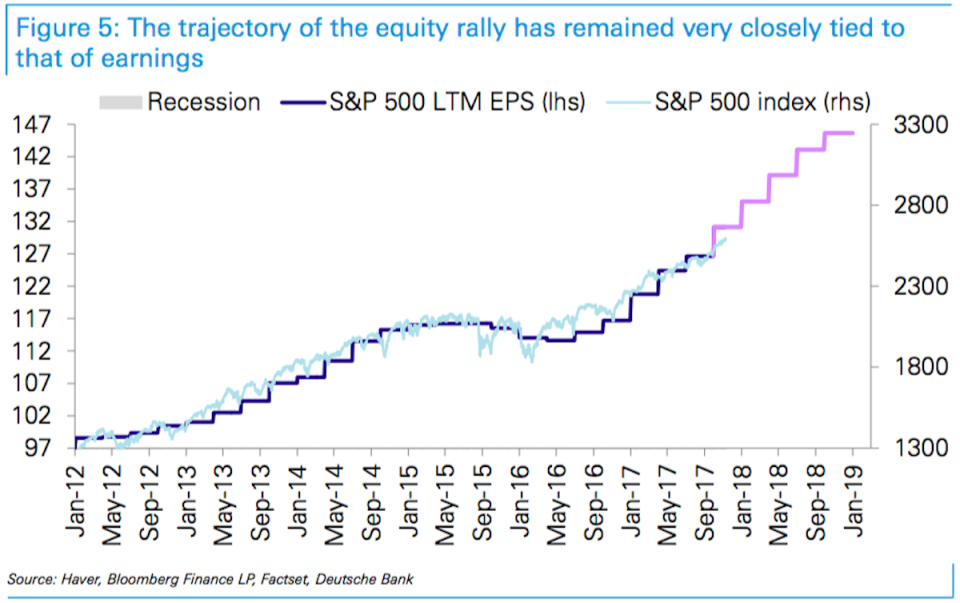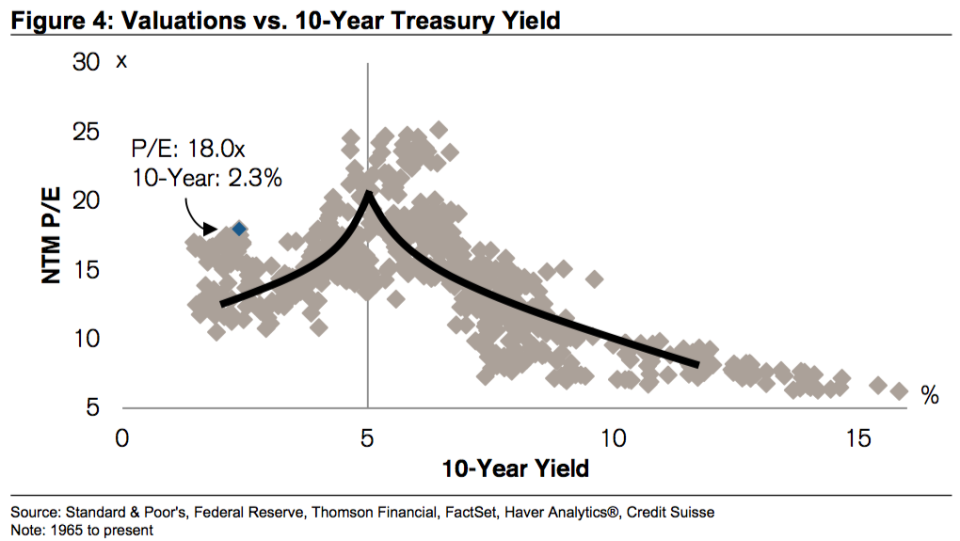Wall Street's stock market forecasters agree — 2018 will be great
UPDATE: Strategists have already begun raising their 2018 targets.
Wall Street’s stock market strategists have begun unveiling their targets for 2018, and the consensus is bullish. Credit Suisse, Deutsche Bank, UBS, and BMO Capital are among firms telling their clients to prepare for double-digit gains in the S&P 500 (^GSPC).
The basic narrative: domestic and international economic growth will continue to boost earnings, while low interest rates will keep valuations high.
In a note to clients on Friday, BMO Capital’s Brian Belski said he saw the S&P climbing to 2,950 by the end of 2018 in his base case scenario. That’s 14% higher than where the S&P closed on Friday.
“U.S. corporate earnings and the economy are improving, a trend that should propel stock prices higher again in 2018,” Belski said. His base case assumes three things: “Risk premiums remain largely static and path of interest rates grinds higher, but slower than expected; EPS growth matches current optimistic expectations providing a layer of support; and Policy questions/debate persist creating periods of elevated volatility surrounding the rhetoric.”
“We believe it is time to accept fundamentals and turn off the rhetoric,” Belski said.

Economists and investors have increasingly been characterizing the U.S. economy as being like “Goldilocks,” a scenario in which inflation is low and growth is above-trend. This is a type of setup that can keep this 8-year-old bull market going for years.
The upside is more likely than the downside – UBS
On Wednesday, UBS’s Keith Parker said the S&P 500 would close 2018 at 2,900. Regarding policy, Parker said that he saw the market going even higher should tax cuts get put into law.
“We think our upside case, based on Congress delivering a tax cut, is more likely than our downside scenario and upside potential (S&P 500 at 3,300) outweighs the downside case by 2x,” Parker said. “As the Fed continues to hike, equity valuations are seemingly pricing in higher rates, but not pricing higher expected medium-term profit growth or lower fundamental earnings volatility.”
Parker sees the market being driven by four themes: demographic shifts benefiting health care, home builders, insurance, household products and cars; rising corporate profits fueling business spending, which outpaces personal consumption growth driven by a falling personal savings rate; rising profit margins driven by productivity gains; and companies with high tax rates outperforming those with low tax rates.
The rally has been tied to earnings – Deutsche Bank
Deutsche Bank’s Binky Chadha sees the S&P heading to 2,850. While it’s a bit more conservative than his peers, it nevertheless assumes a 10% gain from where the market closed on Friday.
In his research note, which was published on Nov. 10, Chadha highlighted how the market’s moves have been closely tied to earnings.

“Following the ECB’s move to negative rates in mid-2014 and the subsequent dollar and oil shocks, earnings growth first slowed then turned negative and equities became range bound for a year and a half,” Chadha observed. “In the context of the trend channel, the range bound S&P 500 moved from the top to the bottom of the trend channel, falling briefly below during the Q1 2016 growth scare and the trough in earnings. Following the Q1 2016 bottom in earnings, equity prices began to rise, briefly breaking their 1 1?2 year range to reach a new peak in mid-2016; then paused as is typical in the run up to close presidential elections before rebounding strongly after.”
Chadha expects S&P earnings per share (EPS) to climb to $146 in 2018, up 11% from the $131 estimated for 2017. He sees the market’s price/earnings (P/E) multiple “essentially remaining flat,” which means stocks will once again track earnings.
Multiples could expand – Credit Suisse
Not everyone expects the market’s multiple to be flat. In fact, there are probably folks who think the multiple should shrink.
And then there are analysts like Credit Suisse’s Jonathan Golub, who thinks the multiple could actually expand.
“Conventional wisdom holds that rising rates threaten equity valuations,” Golub said in a Nov. 13 note to clients. “By contrast, the data shows that when yields are depressed — as they are today — stock prices and interest rates move in tandem.”

“P/Es have historically moved higher until the 10-year Treasury reaches 5%. However, the research presented in this note shows that this tipping point has likely fallen to 3 1?2%, in response to the current slower-growth environment. With Treasury yields below 2 1?2% today, this implies that stock valuations will not be challenged by rising rates for quite some time.”
In an Oct. 9 note to clients, Golub first told clients that he saw the S&P ending 2018 at 2,875. He expects earnings to grow at a mid-single digit pace, but he expects stock prices to get an extra push from expanding multiples.
Here’s a summary of the targets mentioned:
BMO Capital’s Brian Belski: 2018 target 2,950; EPS $145
UBS’s Keith Parker: 2018 target 2,900; EPS $141
Deutsche Bank’s Binky Chadha: 2018 target 2,850; EPS $146
Credit Suisse’s Jonathan Golub: 2018 target 2,875; EPS $139
For a little more context, click here for what Wall Street had predicted for 2017.
–
Sam Ro is managing editor at Yahoo Finance.
Read more: